By all accounts, 2016 was an absolute mess of a year. The deaths of David Bowie and Carrie Fisher bookended a long stream of miserable events, not the least of which being that the US elected a fascist and my seven-year relationship was ending. In comparison, 2017 fared marginally better: I made a cross-country move that I’d always wanted to make, which opened up new possibilities for balance in my life. (There was still the fascist, though.)
I’ve wanted to try out text sentiment analysis ever since I saw this talk on analyzing Bowie’s personas throughout his career. The website demonstrating the analysis is simple: given all the song lyrics of an album, IBM’s Watson would be able to tell you, based on adjectives and whatnot, whether the text comes off as happy, sad, angry, calm, and so on. According to the Personality Insights documentation:
Many contemporary personality psychologists believe that there are five basic dimensions of personality: extraversion, agreeableness, openness, conscientiousness and neuroticism.
Despite a tendency towards introversion, I’ve routinely expressed myself under the relative anonymity of the Internet. When I was a teen, I used my LiveJournal as a place to vent; these days, I turn to Twitter to overshare damn near everything. I rarely censor myself, though occasionally I’m self-aware enough to delete tweets if I believe that they’re too upsetting.
Towards the end of last year, I wanted to know “objectively” whether 2017 was a better year or not. Using Watson, I decided to analyze my tweeting patterns between the two years and see how my persona had changed. If you’re interested in running your own experiment, all the code is available on GitHub.
Extraversion
Energy, positive emotions, surgency, assertiveness, sociability and the tendency to seek stimulation in the company of others, and talkativeness. High extraversion is often perceived as attention-seeking, and domineering. Low extraversion causes a reserved, reflective personality, which can be perceived as aloof or self-absorbed.
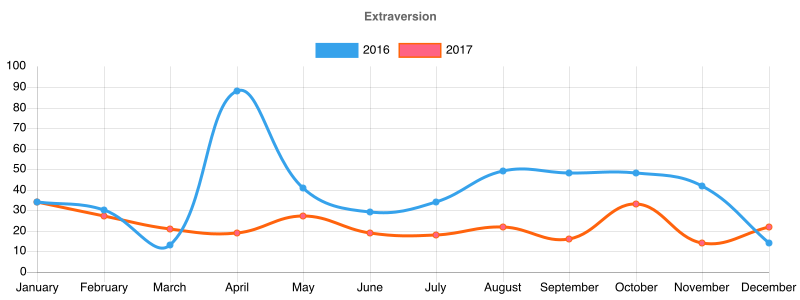
In almost no way, shape, or form would I call myself “attention-seeking,” though I’ve got to admit that anyone who publishes anything on the Internet—tweets, selfies, art, software—must hope, on some level, to ensnare validation from someone in the universe.
I consider the lows of 2017 here to be something closer to a standard. The May 2017 bump might be a result of me moving. I’m not sure what that October 2017 bump might be; the only significant event I see is winning a writing contest. The higher ranking of 2016 was probably the result of my attempts to pretend to the world how well-adjusted and wonderful life was. The high of April is extremely interesting: those would be from tweets that accompanied my first trip through Texas, which saw visits to breweries and the consumption of twelve tacos at a festival.
Agreeableness
A tendency to be compassionate and cooperative rather than suspicious and antagonistic towards others. It is also a measure of one’s trusting and helpful nature, and whether a person is generally well-tempered or not. High agreeableness is often seen as naive or submissive. Low agreeableness personalities are often competitive or challenging people, which can be seen as argumentative or untrustworthy.
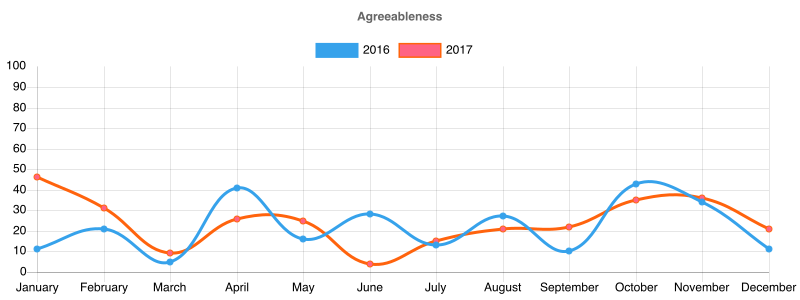
I’m not totally sure what to make of this one. I wouldn’t consider myself so misanthropic as to be consistently below a 50% mark here, but data doesn’t lie.
I think it’s interesting that 2016 had a repetitive variation, with December finishing at right about the same level as January.
March 2017 I had made the decision to move, which might explain the plummet in my “naivety.” I can’t really explain the low dip in June 2017, other than the fact that I was traveling for much of May 2017. Maybe by the time I got back home I realized that I needed to be more “competitive” with myself.
Openness
Appreciation for art, emotion, adventure, unusual ideas, curiosity, and variety of experience. It reflects the degree of intellectual curiosity, creativity and a preference for novelty and variety a person has. It is also described as the extent to which a person is imaginative or independent, and depicts a personal preference for a variety of activities over a strict routine.
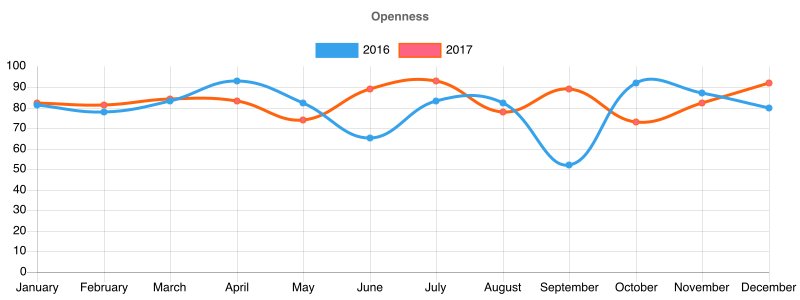
I’m pretty stoked that between the two years, my sentiments around this type remained at a fairly consistent high ranking.
It seems like my attitude towards new experiences went on an upswing after May 2017, when I moved. The massive dip in September 2016 might’ve been work-related: GitHub launched a GraphQL API at the beginning of the month. In trying to interpret this, I could absolutely see how months of crunch time work leading up to the public announcement would cause me to completely shut off from “a variety of activities” in favor of just tuning out for a few weeks.
Conscientiousness
A tendency to be organized and dependable, show self-discipline, act dutifully, aim for achievement, and prefer planned rather than spontaneous behavior. High conscientiousness are often perceived as stubborn and obsessive. Low conscientiousness are flexible and spontaneous, but can be perceived as sloppy and unreliable.
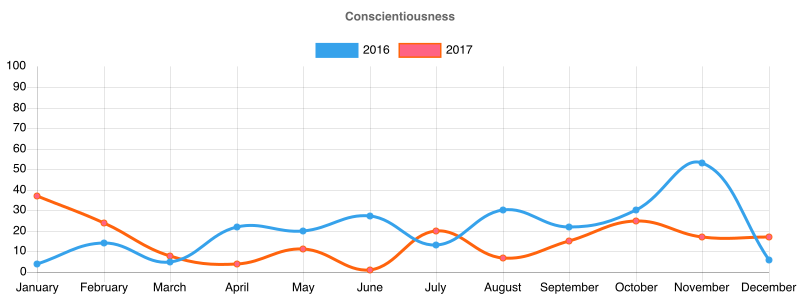
These are pretty low numbers, but I can’t disagree that I’m “flexible” and “sloppy” in general.
Given that higher numbers means a tendency towards planning, I am surprised none of the months during my move reflected this, because that required an enormous amount of coordination. I guess I wasn’t really tweeting about this mundane details. The uptick in November 2016 is almost certainly due to politicizing after the election, with tweets about being ready to fight, trolling Trump, and rules for surviving autocracies.
Neuroticism
The tendency to experience unpleasant emotions easily, such as anger, anxiety, depression, and vulnerability. Neuroticism also refers to the degree of emotional stability and impulse control and is sometimes referred to by its low pole, “emotional stability”. A high need for stability manifests as a stable and calm personality, but can be seen as uninspiring and unconcerned. A low need for stability causes a reactive and excitable personality, often very dynamic individuals, but they can be perceived as unstable or insecure.
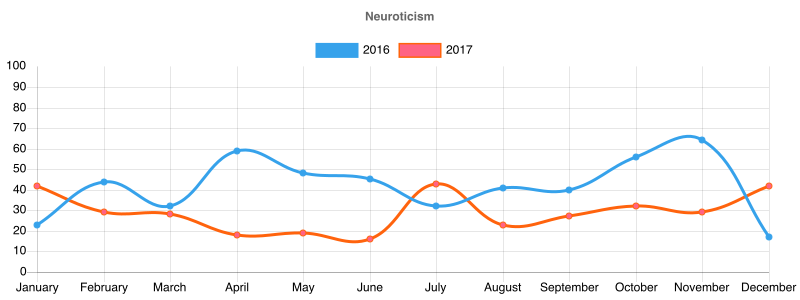
It’s not that I want to be neurotic, but I would definitely say I’m neurotic. The numbers here aren’t too surprising.
Given that the lows are described as “unstable or insecure,” it’s interesting how closely this aligns with Conscientiousness’ fluctuations above mapping to “sloppy and unreliable.” In other words, the patterns here seem to match up, with each emote rising and falling at around the same time.
I’m not quite sure what July 2017 could’ve been, other than another road trip to Texas. It certainly seems like it was the calmest portion of the year.